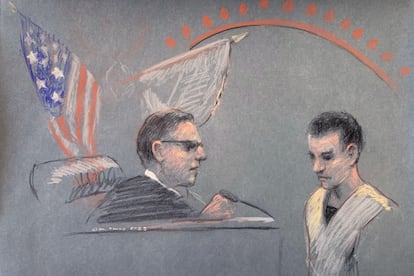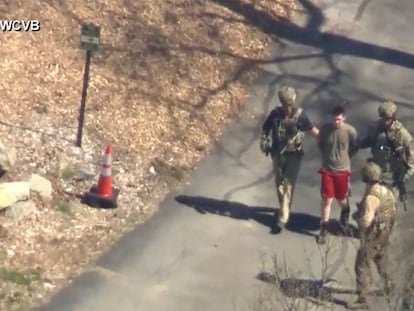How could a simple recruit have access to so many Pentagon military secrets?
The U.S. Department of Defense is reviewing the lists of people with permission to see sensitive information after the leak attributed to the young Massachusetts Air National Guardsman Jack Teixeira


How is it possible that a 21-year-old recruit had access to classified military information that was reserved, in theory, only for the highest command? And how is it possible that he was able to copy and distribute those documents for months without the Pentagon noticing? These are some of the questions raised by the arrest of Massachusetts Air National Guardsman Jack Teixeira, who is suspected of being behind the largest — and most embarrassing — leak of official secrets in the US since WikiLeaks in 2010. To answer these questions, it is necessary to revisit the attacks of September 11, 2001.
Teixeira joined the National Guard, an auxiliary military corps whose main mission is to defend the United States in the event of war, immediately after graduating from high school three years ago. Following a background check, required for entry into jobs related to national security, he received clearance for access to high-level classified information. His assignment to an intelligence unit, in which he had to ensure that communications flowed properly as an information technology specialist responsible for military communications networks, gave him access to restricted areas.
Like him, there are thousands, or tens of thousands, of people throughout the United States authorized to receive classified information, at various levels of secrecy: military personnel, defense contractors, security experts, diplomats and even some analysts from research centers. Permission to access such classified information opens the door to Pentagon documentation, intelligence analysis, maps, and restricted web pages.
Teixeira, according to documents presented by the prosecution at a preliminary hearing held this Friday in Boston, had access to a wide range of information in terms of sensitivity and subject matter. Most of what the suspect allegedly leaked involved the war in Ukraine, but also other parts of the world, according to the FBI.
His age in itself is not relevant, according to the Department of Defense, whose spokesman, Pat Ryder, recalled the enormous responsibilities that the Pentagon places on very young soldiers when it comes to leading troops in combat. More relevant is the type of task that Teixeira was assigned. And it seems clear that to perform his duties he did not necessarily need to know the territorial distribution of the Ukrainian troops or the equipment of the Chinese balloon that flew over the United States at the beginning of the year. Yet he allegedly shared information about both with his friends in a private chat group of Discord, a social media platform popular with online gamers.
“There was no reason for him to have access to this information except a system that granted too much access,” tweeted Juliette Kayyem, a former assistant secretary of Homeland Security for Massachusetts Governor Deval Patrick who oversaw Air National Guard units.
It is a situation that goes back to 9/11 and the attacks against the World Trade Center in New York and the Pentagon, according to representatives of the intelligence services. Back then, intelligence agencies were at the opposite end of the spectrum: they had an excessively compartmentalized system, where one department did not share its information with the department next door. This lack of coordination prevented intelligence agencies from connecting the dots about the plans hatched by the Islamic extremist network Al Qaeda, which was able to hijack four passenger planes and crash them, in attacks that cost the lives of more than 3,000 people.
The committee that investigated the 2001 attacks harshly criticized that “on-a-need-to-know-basis” mentality. That position assumes that it is possible to know in advance who will need to make use of that information. The system implicitly assumes that the risk of inadvertent data disclosure outweighs the benefits of sharing it more widely, the report published in 2004 states.
If the pendulum swung back then to facilitate the disclosure of information and for people in charge of national security to have as much data as possible when making decisions, it could now very well swing back in the opposite direction again. The Pentagon is conducting a review and update of its classified document distribution lists to reduce the number of individuals allowed to see sensitive data.
“We continue to work around the clock, along with the intelligence community and other departments, to try to better understand the scope, size and impact of these leaks,” Ryder said. The defense spokesperson also specified that they will continue to do everything possible “to guarantee that the people who have to receive this type of information maintain their access to it.”
The Pentagon has also stressed that this leak was not a mere accident or something unintentional. "It was a deliberate criminal act," Ryder stressed. "A violation of the rules."
Sign up for our weekly newsletter to get more English-language news coverage from EL PAÍS USA Edition
Tu suscripción se está usando en otro dispositivo
¿Quieres añadir otro usuario a tu suscripción?
Si continúas leyendo en este dispositivo, no se podrá leer en el otro.
FlechaTu suscripción se está usando en otro dispositivo y solo puedes acceder a EL PAÍS desde un dispositivo a la vez.
Si quieres compartir tu cuenta, cambia tu suscripción a la modalidad Premium, así podrás añadir otro usuario. Cada uno accederá con su propia cuenta de email, lo que os permitirá personalizar vuestra experiencia en EL PAÍS.
¿Tienes una suscripción de empresa? Accede aquí para contratar más cuentas.
En el caso de no saber quién está usando tu cuenta, te recomendamos cambiar tu contraseña aquí.
Si decides continuar compartiendo tu cuenta, este mensaje se mostrará en tu dispositivo y en el de la otra persona que está usando tu cuenta de forma indefinida, afectando a tu experiencia de lectura. Puedes consultar aquí los términos y condiciones de la suscripción digital.
More information
Últimas noticias
‘Sleepless City’: The light of cinema illuminates Madrid’s Cañada Real shantytown
All the effects of gentrification in one corner of Mexico’s Colonia Roma
Palestinian reporter Youmna El Sayed: ‘My family told me I had to choose between being a journalist or a mother’
The new language of the workplace: Knowing how to ask AI questions is more important than using it
Most viewed
- Families demand repatriation of bodies of Colombians who died in Ukraine: ‘This war is a slaughterhouse for foreigners’
- The low-cost creative revolution: How technology is making art accessible to everyone
- Liset Menéndez de la Prida, neuroscientist: ‘It’s not normal to constantly seek pleasure; it’s important to be bored, to be calm’
- Christian Louboutin: ‘Young people don’t want to be like their parents. And if their parents wear sneakers, they’re going to look for something else’
- ‘El Limones’ and the growing union disguise of Mexican organized crime










































